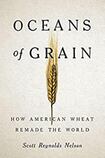
The economic effects of Russia’s invasion of Ukraine have rippled far beyond the countries’ borders, not least in global grain markets. The two countries are among the world’s biggest producers of wheat, their supplies particularly vital for the bread on which Africa and the Middle East rely. With harvests, planting and exports now indefinitely cut off, the UN World Food Programme has warned of shortages and starvation in war-torn Yemen, Syria, Ethiopia and elsewhere.
Ukraine, explains Scott Reynolds Nelson in this sweeping and timely new history, has perhaps “the richest soil in the world”, one that has long been perfect for growing our indispensable staple. Bread is, after all, older than writing, older than cities, older than our domesticated animals. From Ukraine’s vast wheatfields to the Black Sea run the “black paths”, ancient grain routes in which Nelson sees the source of empire. On maps of power and conflict, he argues, we should focus not on the “coloured blobs” of territory, but on the black paths by which food, plagues and trade have always travelled.
Those routes have long been at the heart of Russian imperialism, an ideology for which Ukraine has “always been the greatest prize”. Peter the Great’s victory at Poltava in central Ukraine in 1709 ended Swedish hegemony in northeastern Europe and set Russia on the path to regional dominance. After her conquest of Crimea and the Black Sea coast from the Ottomans in 1774, Catherine the Great extended serfdom into Ukraine, using that exploitation to export huge amounts of grain to finance her growing empire, soon the world’s largest on land.
Odesa as linchpin
Odesa would become the linchpin of this trade, a port city that, as Pushkin wrote, “diffused Europe”, sending out millions of tons of cheap grain to the “gullet cities” of western Europe. Taxes on cheap grain – even after 1848s potato crop failures and liberal revolutions brought freer trade – were the financial lifeblood of agrarian empires.
The following decades, however, would see a tectonic shift in who fed Europe. Wars – in Crimea and in the American south – led the Russian and American empires to abolish serfdom and slavery at almost the exact same time. While Russia’s imperial expansion stalled after its defeat in Crimea, America’s intensified westward, with railroads and shipping bringing Kansas as “close” to western Europe as Kherson.
Innovations in milling and transport would drive the price of American grain so low that it transformed the shape of Europe. Growing industrial cities were fed by cheap grain while millions of peasants emigrated across the Atlantic on the ships that had “dumped” it on the old world. The balance of global political and economic power shifted westwards.
Nelson follows the thoughts and career of Alexander Helphand (also known as Parvus), a Bolshevik revolutionary who agreed that the paths of grain “made and destroyed empires”. Colourfully dressed, fluent in six languages, and involved in everything from grain-trading to gun-running, Parvus played a role in the collapse of both Russian and Ottoman empires during the Great War, a conflict Nelson calls “a world war over bread”. The imperial powers, he argues, were fighting for control for a “food-trade-tax nexus”, with strategic eyes on their weakness to starvation through blockades of the Bosphorous and the Atlantic.
Bread distribution
Even after the communist revolution that Parvus sought (and helped foment through secret negotiations with Germany), grain would remain central to Russian imperialism. The new Soviet Union defined itself through its power over the distribution of bread, and only by absorbing Ukraine – and then subjugating it through the artificial famine known as the Holodomor – was the Soviet “experiment” possible. Nelson’s argument that Russia’s “relative weakness” today is tied to its “separation from Ukraine” feels darkly prescient.
Nelson combines his grand narrative with fascinating diversions on everything from explosives to financial panics. In correcting those who dismiss or underestimate the importance of grain, he perhaps goes too far in using it to explain almost everything. He candidly admits this felt like “an impossible book” to write, but in its ambition it is vitally provocative, forcing us to reassess not just the sources of imperial power and the nature of trade, but how we think about history itself.
Russia’s most prized black paths today are its oil and gas pipelines but, as its armies try to starve Ukrainian cities into surrender, Nelson shows how we still must not forget the power of food. The last time Black Sea grain exports fell dramatically – after wildfires in 2010 – bread prices spiked across North Africa and the Middle East, provoking the Arab Spring. “Wars and revolutions now”, Nelson writes, “just as in the past, have much to do with wheat”.
Christopher Kissane is the author of Food, Religion and Communities in Early Modern Europe, and host of the Ireland’s Edge podcast











